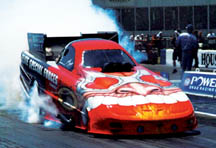|
observer |
|
|
|
|
|
OTHER LINKS |

|

|

|
|
|
 Ice racer with studded tyres |
The engine capacities of ice racing cars can go up to 3000cc and the cars are divided into four categories for competition purposes as, Class One through to Class Four, where they have their own criteria (standard of judgement). These types are called rubber-to-ice classes since the cars in these classes have rubber tyres. For those who really want to speed up, there are metal-to-ice classes.
These are the same classes as above, but with cars having studded tyres to increase traction (action of pull). Ice racing cars are not at all sophisticated and no specific rules for safety are applied. No matter whether the car is a sedan, coupe, station wagon or small pick-up, equipped with automatic or standard transmission, front wheel, rear wheel or all wheel drive, just as long as it is mechanically sound, it can be used for ice racing.
Although this discussion is focused on motor cars, bikes and snow mobiles too engage in ice racing extensively.
Single Seater Racing
As its name implies, only the driver has seating arrangements in the car in this type of racing. Single-seater racing is perhaps the most well-known form of motorsport, with cars designed specifically for high-speed racing.

The wheels are not covered, and the cars often have aerofoil wings at the front and rear to produce downforce and increase the adhesion (grip) to the track. This type of racing takes place on especially designed, closed circuit tracks. The cars race at speeds often greater than 300 km/h (about 190 mph).
You surely must have heard of Formula One racing, haven't you? Well, this is the best known variety of single seater racing. This type of racing is by far the most expensive type of motor car racing due to the cost of research and technology, which may exceed even 200 million US dollars per year. The major engine manufacturers such as Ferrari, BMW, McLarren, Toyota and Honda are on a perpetual battle to come up with the best car and the best driver.
There are many variants (differences) in single seater racing. The A1 Grand Prix is the World Cup of motorsport. GP2, which was formerly known as Formula 3,000 and Formula Two, Formula Nippon, Formula Renault 3.5 which is also known as the World Series by Renault, Formula Three and Formula Atlantic are a few main racing series.
Drag Racing
'Drag Racing' is sure to ring a bell in your mind if you are a great lover of car racing games. Well, here are facts about the real world stuff. Drag racing is all about getting the maximum acceleration out of the car.
|
|
Drag racing originated in the United States and is still the most popular type of car racing there. Basically, a proper drag race involves two cars racing each other over a set distance, which is preferably a quarter of a mile, although one eighth of a mile is also popular.
Although the driver does not have any turns to negotiate or opponents to defend against, apart from the competitor in the other lane, he must be very accurate with gear shifting and throttle modulation. The 'burnout' is a unique feature in this type of racing where the rear wheels are spun after making them wet while they retain contact with the track in order to heat and make the tyres stickier and result in a swift start-off.
During drag racing events, vehicles are classified into different divisions by various criteria which include engine capacity, configuration of cylinders, frame type, vehicle construction materials, wheelbase, horsepower to weight ratio, number of cylinders, whether or not power adding devices such as turbochargers, superchargers or nitrous oxide are employed, vehicle type etc.
*****
Correction
The image under Stock Car Racing in the previous article belongs to Rally Racing and it should be replaced by the picture on the right. We regret the error.









